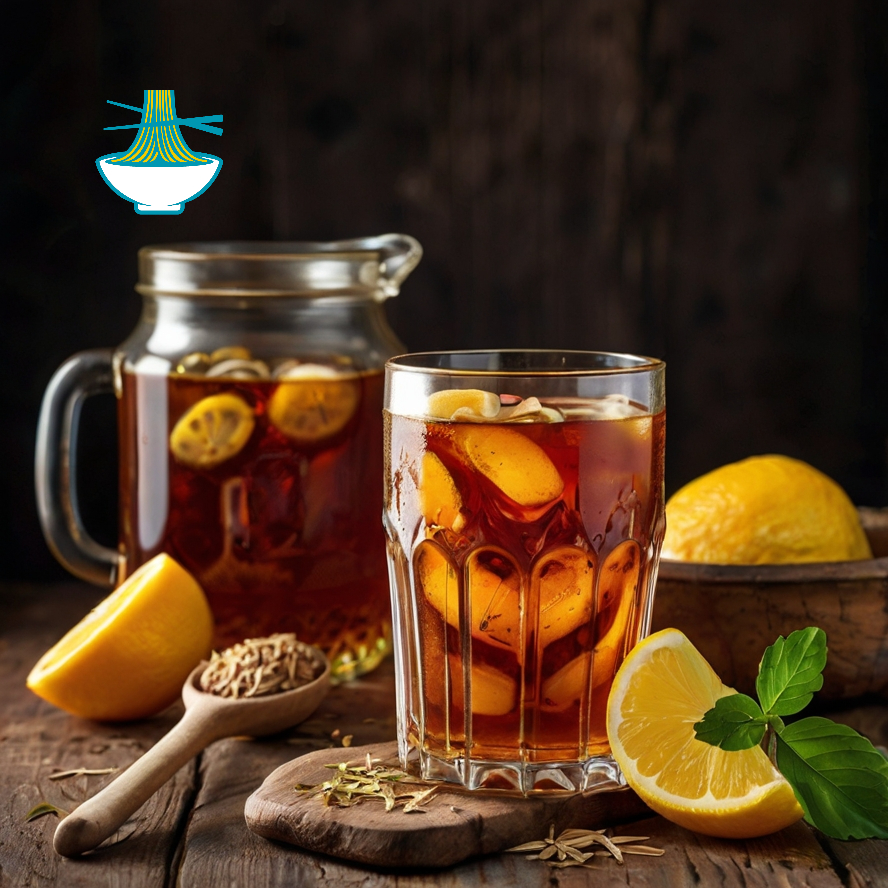Kvass is a traditional fermented beverage originating from Eastern Europe, particularly Russia and Ukraine. Made primarily from rye bread, water, and yeast, it undergoes a fermentation process that results in a slightly alcoholic and tangy drink. Kvass can be flavored with various fruits or herbs, adding complexity to its taste profile. Refreshing and invigorating, it has been enjoyed for centuries as a staple in the region's culinary and cultural traditions.
The history of kvass dates back centuries, with its origins rooted in medieval Eastern Europe. Initially brewed as a way to utilize stale bread, kvass quickly gained popularity due to its refreshing taste and purported health benefits. It became a staple beverage for peasants and workers, providing hydration and nourishment during long days of labor. Over time, the recipe evolved, with different regions adding their own unique twists and variations. Despite its humble beginnings, kvass remains a beloved cultural icon, cherished for its rich history and distinctive flavor.
Ingredients:
- 1 pound (450g) rye bread, preferably stale
- 4 quarts (4 liters) water
- ½ cup (100g) sugar, or to taste
- ¼ teaspoon active dry yeast
Optional Flavorings:
- Fresh fruits (such as berries, apples, or raisins)
- Herbs (such as mint or dill)
Method:
- Cut the rye bread into small cubes or slices.
- In a large pot, bring the water to a boil, then remove from heat.
- Add the bread cubes to the hot water and let steep for 4-6 hours, or overnight, until the water turns dark and absorbs the flavor of the bread.
- Strain the liquid through a fine-mesh sieve or cheesecloth into a clean container, pressing down on the bread to extract as much liquid as possible.
- Discard the bread solids and return the liquid to the pot.
- Stir in the sugar until dissolved.
- Sprinkle the yeast over the liquid and let it sit for 10-15 minutes to activate.
- Transfer the liquid to a clean, airtight container and cover loosely with a lid or cloth.
- Let the kvass ferment at room temperature for 1-3 days, depending on desired level of fermentation and taste. Check periodically for desired flavor and carbonation.
- Once fermented to your liking, transfer the kvass to bottles or jars and refrigerate to halt the fermentation process.
- Serve chilled and enjoy your homemade kvass!
Nutrition Value:
Rye Bread (1 pound, preferably stale):
- Calories: Approximately 1160 calories
- Carbohydrates: Around 230 grams
- Protein: About 30 grams
- Fat: Roughly 10 grams
- Sodium: Varies depending on the bread, typically around 1000 mg
- Cholesterol: Typically zero, as rye bread is usually low in cholesterol
- Vitamins & Minerals: Rye bread is a good source of B vitamins, including niacin, thiamine, and riboflavin. It also contains minerals like iron, magnesium, and zinc.
Benefit: Rye bread provides complex carbohydrates for energy, dietary fiber for digestive health, and various vitamins and minerals essential for overall well-being.
Water (4 quarts):
- Calories: Zero
- Carbohydrates: Zero
- Protein: Zero
- Fat: Zero
- Sodium: Zero
- Cholesterol: Zero
- Vitamins & Minerals: While water doesn't contain vitamins or minerals, it's essential for hydration and various bodily functions.
Benefit: Water helps maintain proper hydration, regulates body temperature, aids digestion, and supports overall bodily functions.
Sugar (½ cup, or 100g):
- Calories: Approximately 387 calories
- Carbohydrates: About 100 grams
- Protein: Zero
- Fat: Zero
- Sodium: Negligible
- Cholesterol: Zero
- Vitamins & Minerals: Sugar typically lacks significant vitamins and minerals.
Benefit: While sugar provides quick energy due to its high carbohydrate content, it should be consumed in moderation. In this recipe, sugar likely serves as a sweetener for flavor enhancement.
Active Dry Yeast (¼ teaspoon):
- Calories: Negligible
- Carbohydrates: Negligible
- Protein: Negligible
- Fat: Negligible
- Sodium: Negligible
- Cholesterol: Zero
- Vitamins & Minerals: Yeast contains small amounts of B vitamins, including B1 (thiamine), B2 (riboflavin), B3 (niacin), B5 (pantothenic acid), and B9 (folate).
Benefit: Yeast is essential for fermentation in baking, contributing to the leavening and flavor development of bread. It also provides some B vitamins, which are important for energy metabolism and other bodily functions.
Optional Flavorings:
Fresh Fruits (such as berries, apples, or raisins):
- Calories: Varies depending on the type and quantity of fruits used.
- Carbohydrates: Primarily from natural sugars, varying based on the fruit.
- Protein: Typically low, though some fruits like berries may contain small amounts.
- Fat: Negligible.
- Sodium: Minimal.
- Cholesterol: Zero.
- Vitamins & Minerals: Fruits are rich in various vitamins such as vitamin C, vitamin A, potassium, and folate, depending on the type of fruit.
Benefit: Fresh fruits provide essential vitamins, minerals, and dietary fiber. They are naturally low in calories and fat, making them a healthy addition to the diet. Berries, in particular, are rich in antioxidants, while apples provide fiber, and raisins offer natural sweetness along with some iron and potassium.
Herbs (such as mint or dill):
- Calories: Negligible.
- Carbohydrates: Minimal.
- Protein: Minimal.
- Fat: Negligible.
- Sodium: Minimal.
- Cholesterol: Zero.
- Vitamins & Minerals: Herbs can be a good source of certain vitamins and minerals, depending on the type. For example, mint contains small amounts of vitamin A and vitamin C, while dill provides vitamin A, vitamin C, and calcium.
Benefit: Herbs add flavor, aroma, and visual appeal to dishes without significantly contributing to calorie or macronutrient content. Additionally, some herbs contain phytonutrients with potential health benefits, such as anti-inflammatory or antioxidant properties. Overall, herbs are a nutritious way to enhance the taste and nutritional profile of dishes.


Comments